Strategy and Case Analysis
VerifiedAdded on 2023/01/18
|15
|3673
|81
AI Summary
This report analyzes the airlines industry of USA and the business market in which it is operational. It provides an overview of the industry, conducts a PESTLE analysis, analyzes competition, identifies opportunities and threats, and suggests potential strategies for profitability.
Contribute Materials
Your contribution can guide someone’s learning journey. Share your
documents today.
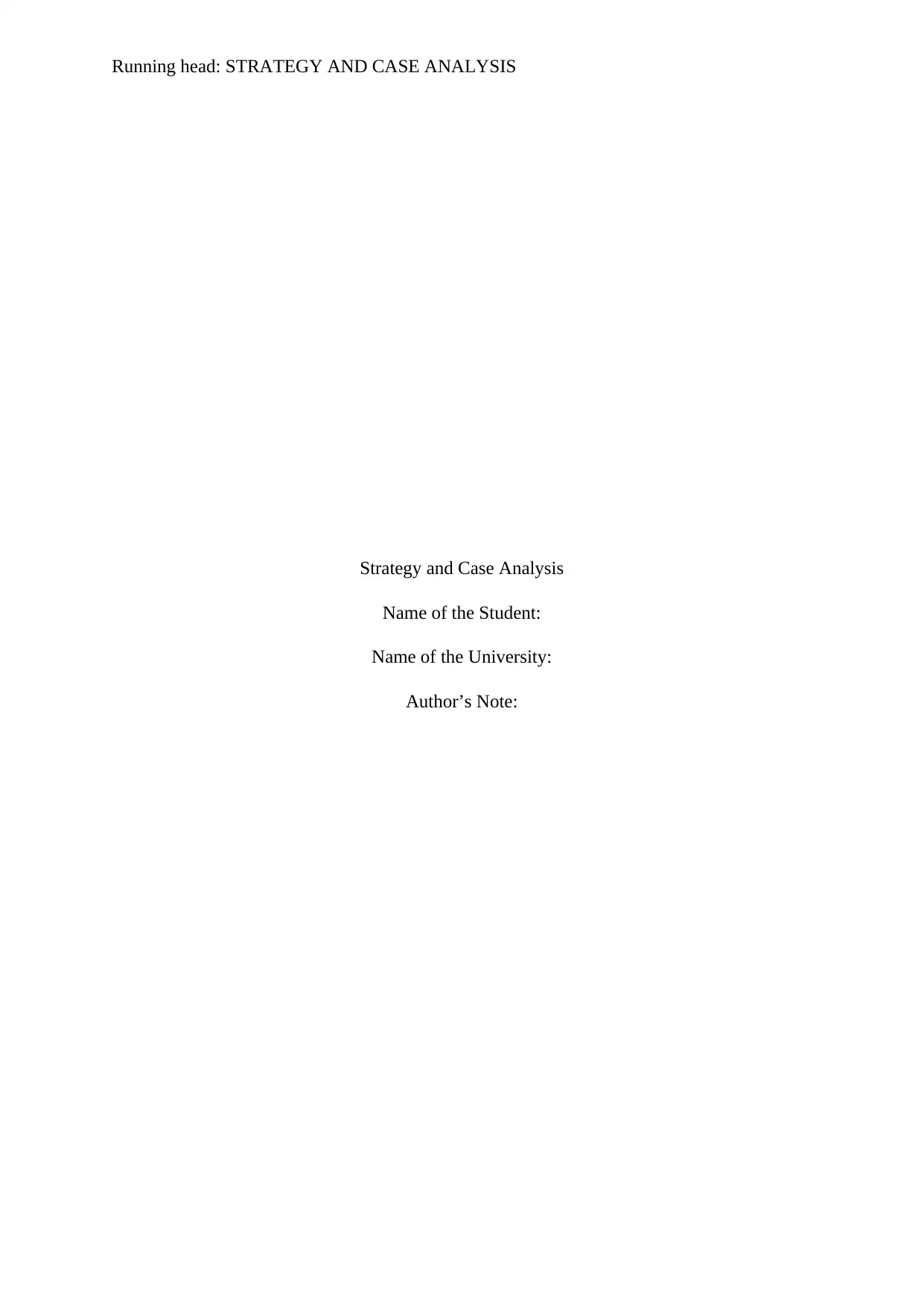
Running head: STRATEGY AND CASE ANALYSIS
Strategy and Case Analysis
Name of the Student:
Name of the University:
Author’s Note:
Strategy and Case Analysis
Name of the Student:
Name of the University:
Author’s Note:
Secure Best Marks with AI Grader
Need help grading? Try our AI Grader for instant feedback on your assignments.
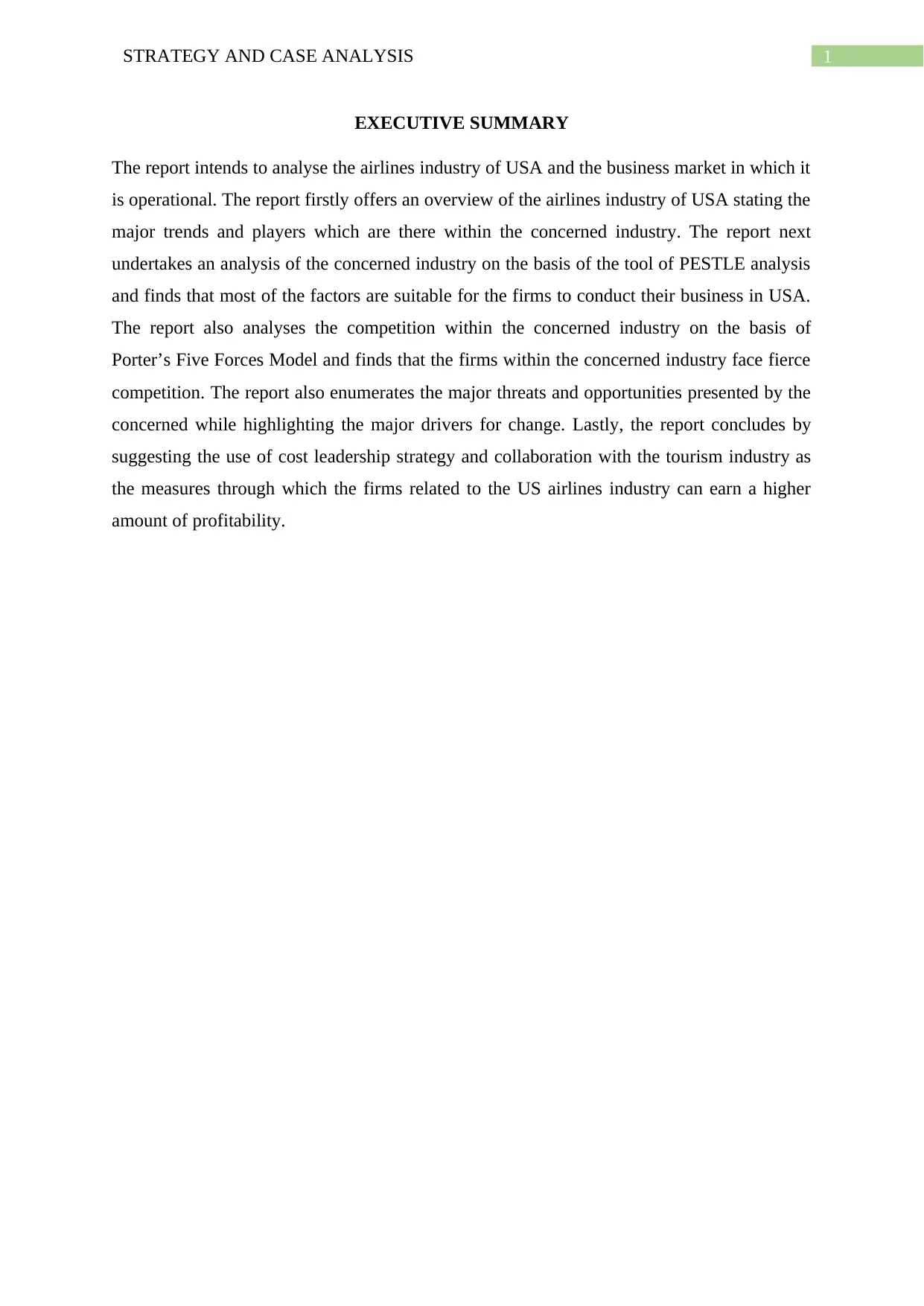
1STRATEGY AND CASE ANALYSIS
EXECUTIVE SUMMARY
The report intends to analyse the airlines industry of USA and the business market in which it
is operational. The report firstly offers an overview of the airlines industry of USA stating the
major trends and players which are there within the concerned industry. The report next
undertakes an analysis of the concerned industry on the basis of the tool of PESTLE analysis
and finds that most of the factors are suitable for the firms to conduct their business in USA.
The report also analyses the competition within the concerned industry on the basis of
Porter’s Five Forces Model and finds that the firms within the concerned industry face fierce
competition. The report also enumerates the major threats and opportunities presented by the
concerned while highlighting the major drivers for change. Lastly, the report concludes by
suggesting the use of cost leadership strategy and collaboration with the tourism industry as
the measures through which the firms related to the US airlines industry can earn a higher
amount of profitability.
EXECUTIVE SUMMARY
The report intends to analyse the airlines industry of USA and the business market in which it
is operational. The report firstly offers an overview of the airlines industry of USA stating the
major trends and players which are there within the concerned industry. The report next
undertakes an analysis of the concerned industry on the basis of the tool of PESTLE analysis
and finds that most of the factors are suitable for the firms to conduct their business in USA.
The report also analyses the competition within the concerned industry on the basis of
Porter’s Five Forces Model and finds that the firms within the concerned industry face fierce
competition. The report also enumerates the major threats and opportunities presented by the
concerned while highlighting the major drivers for change. Lastly, the report concludes by
suggesting the use of cost leadership strategy and collaboration with the tourism industry as
the measures through which the firms related to the US airlines industry can earn a higher
amount of profitability.
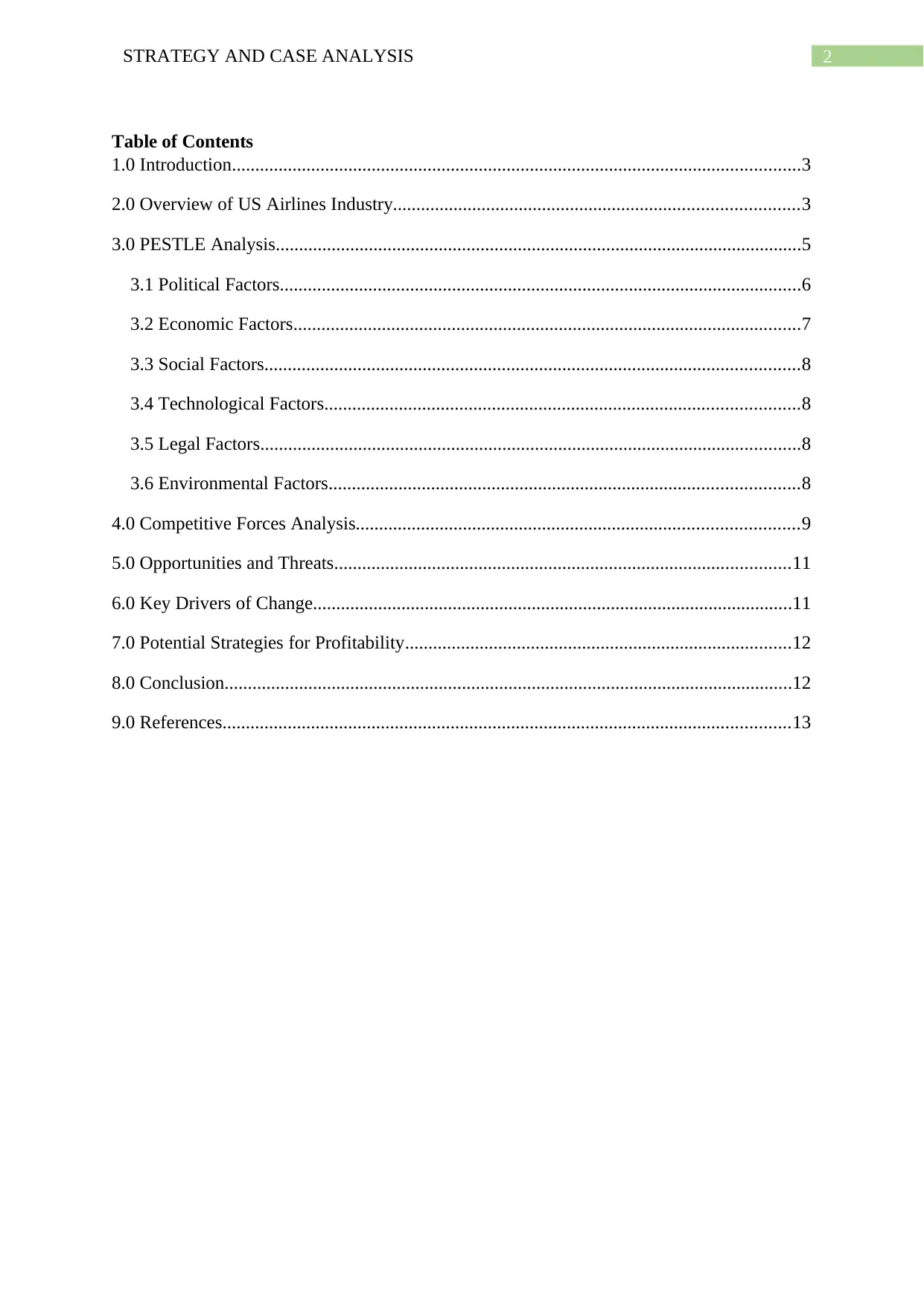
2STRATEGY AND CASE ANALYSIS
Table of Contents
1.0 Introduction..........................................................................................................................3
2.0 Overview of US Airlines Industry.......................................................................................3
3.0 PESTLE Analysis.................................................................................................................5
3.1 Political Factors................................................................................................................6
3.2 Economic Factors.............................................................................................................7
3.3 Social Factors...................................................................................................................8
3.4 Technological Factors......................................................................................................8
3.5 Legal Factors....................................................................................................................8
3.6 Environmental Factors.....................................................................................................8
4.0 Competitive Forces Analysis...............................................................................................9
5.0 Opportunities and Threats..................................................................................................11
6.0 Key Drivers of Change.......................................................................................................11
7.0 Potential Strategies for Profitability...................................................................................12
8.0 Conclusion..........................................................................................................................12
9.0 References..........................................................................................................................13
Table of Contents
1.0 Introduction..........................................................................................................................3
2.0 Overview of US Airlines Industry.......................................................................................3
3.0 PESTLE Analysis.................................................................................................................5
3.1 Political Factors................................................................................................................6
3.2 Economic Factors.............................................................................................................7
3.3 Social Factors...................................................................................................................8
3.4 Technological Factors......................................................................................................8
3.5 Legal Factors....................................................................................................................8
3.6 Environmental Factors.....................................................................................................8
4.0 Competitive Forces Analysis...............................................................................................9
5.0 Opportunities and Threats..................................................................................................11
6.0 Key Drivers of Change.......................................................................................................11
7.0 Potential Strategies for Profitability...................................................................................12
8.0 Conclusion..........................................................................................................................12
9.0 References..........................................................................................................................13
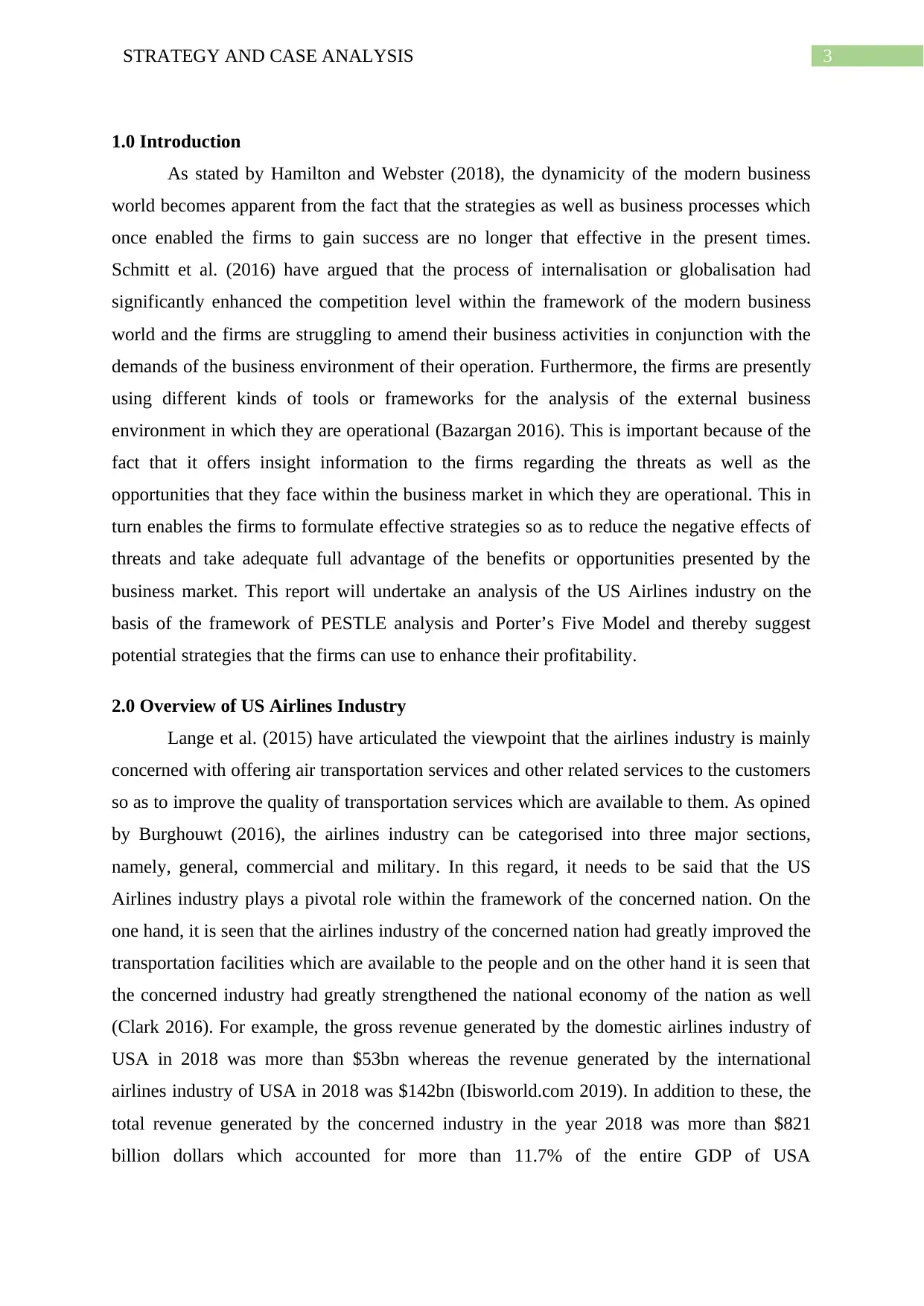
3STRATEGY AND CASE ANALYSIS
1.0 Introduction
As stated by Hamilton and Webster (2018), the dynamicity of the modern business
world becomes apparent from the fact that the strategies as well as business processes which
once enabled the firms to gain success are no longer that effective in the present times.
Schmitt et al. (2016) have argued that the process of internalisation or globalisation had
significantly enhanced the competition level within the framework of the modern business
world and the firms are struggling to amend their business activities in conjunction with the
demands of the business environment of their operation. Furthermore, the firms are presently
using different kinds of tools or frameworks for the analysis of the external business
environment in which they are operational (Bazargan 2016). This is important because of the
fact that it offers insight information to the firms regarding the threats as well as the
opportunities that they face within the business market in which they are operational. This in
turn enables the firms to formulate effective strategies so as to reduce the negative effects of
threats and take adequate full advantage of the benefits or opportunities presented by the
business market. This report will undertake an analysis of the US Airlines industry on the
basis of the framework of PESTLE analysis and Porter’s Five Model and thereby suggest
potential strategies that the firms can use to enhance their profitability.
2.0 Overview of US Airlines Industry
Lange et al. (2015) have articulated the viewpoint that the airlines industry is mainly
concerned with offering air transportation services and other related services to the customers
so as to improve the quality of transportation services which are available to them. As opined
by Burghouwt (2016), the airlines industry can be categorised into three major sections,
namely, general, commercial and military. In this regard, it needs to be said that the US
Airlines industry plays a pivotal role within the framework of the concerned nation. On the
one hand, it is seen that the airlines industry of the concerned nation had greatly improved the
transportation facilities which are available to the people and on the other hand it is seen that
the concerned industry had greatly strengthened the national economy of the nation as well
(Clark 2016). For example, the gross revenue generated by the domestic airlines industry of
USA in 2018 was more than $53bn whereas the revenue generated by the international
airlines industry of USA in 2018 was $142bn (Ibisworld.com 2019). In addition to these, the
total revenue generated by the concerned industry in the year 2018 was more than $821
billion dollars which accounted for more than 11.7% of the entire GDP of USA
1.0 Introduction
As stated by Hamilton and Webster (2018), the dynamicity of the modern business
world becomes apparent from the fact that the strategies as well as business processes which
once enabled the firms to gain success are no longer that effective in the present times.
Schmitt et al. (2016) have argued that the process of internalisation or globalisation had
significantly enhanced the competition level within the framework of the modern business
world and the firms are struggling to amend their business activities in conjunction with the
demands of the business environment of their operation. Furthermore, the firms are presently
using different kinds of tools or frameworks for the analysis of the external business
environment in which they are operational (Bazargan 2016). This is important because of the
fact that it offers insight information to the firms regarding the threats as well as the
opportunities that they face within the business market in which they are operational. This in
turn enables the firms to formulate effective strategies so as to reduce the negative effects of
threats and take adequate full advantage of the benefits or opportunities presented by the
business market. This report will undertake an analysis of the US Airlines industry on the
basis of the framework of PESTLE analysis and Porter’s Five Model and thereby suggest
potential strategies that the firms can use to enhance their profitability.
2.0 Overview of US Airlines Industry
Lange et al. (2015) have articulated the viewpoint that the airlines industry is mainly
concerned with offering air transportation services and other related services to the customers
so as to improve the quality of transportation services which are available to them. As opined
by Burghouwt (2016), the airlines industry can be categorised into three major sections,
namely, general, commercial and military. In this regard, it needs to be said that the US
Airlines industry plays a pivotal role within the framework of the concerned nation. On the
one hand, it is seen that the airlines industry of the concerned nation had greatly improved the
transportation facilities which are available to the people and on the other hand it is seen that
the concerned industry had greatly strengthened the national economy of the nation as well
(Clark 2016). For example, the gross revenue generated by the domestic airlines industry of
USA in 2018 was more than $53bn whereas the revenue generated by the international
airlines industry of USA in 2018 was $142bn (Ibisworld.com 2019). In addition to these, the
total revenue generated by the concerned industry in the year 2018 was more than $821
billion dollars which accounted for more than 11.7% of the entire GDP of USA
Secure Best Marks with AI Grader
Need help grading? Try our AI Grader for instant feedback on your assignments.
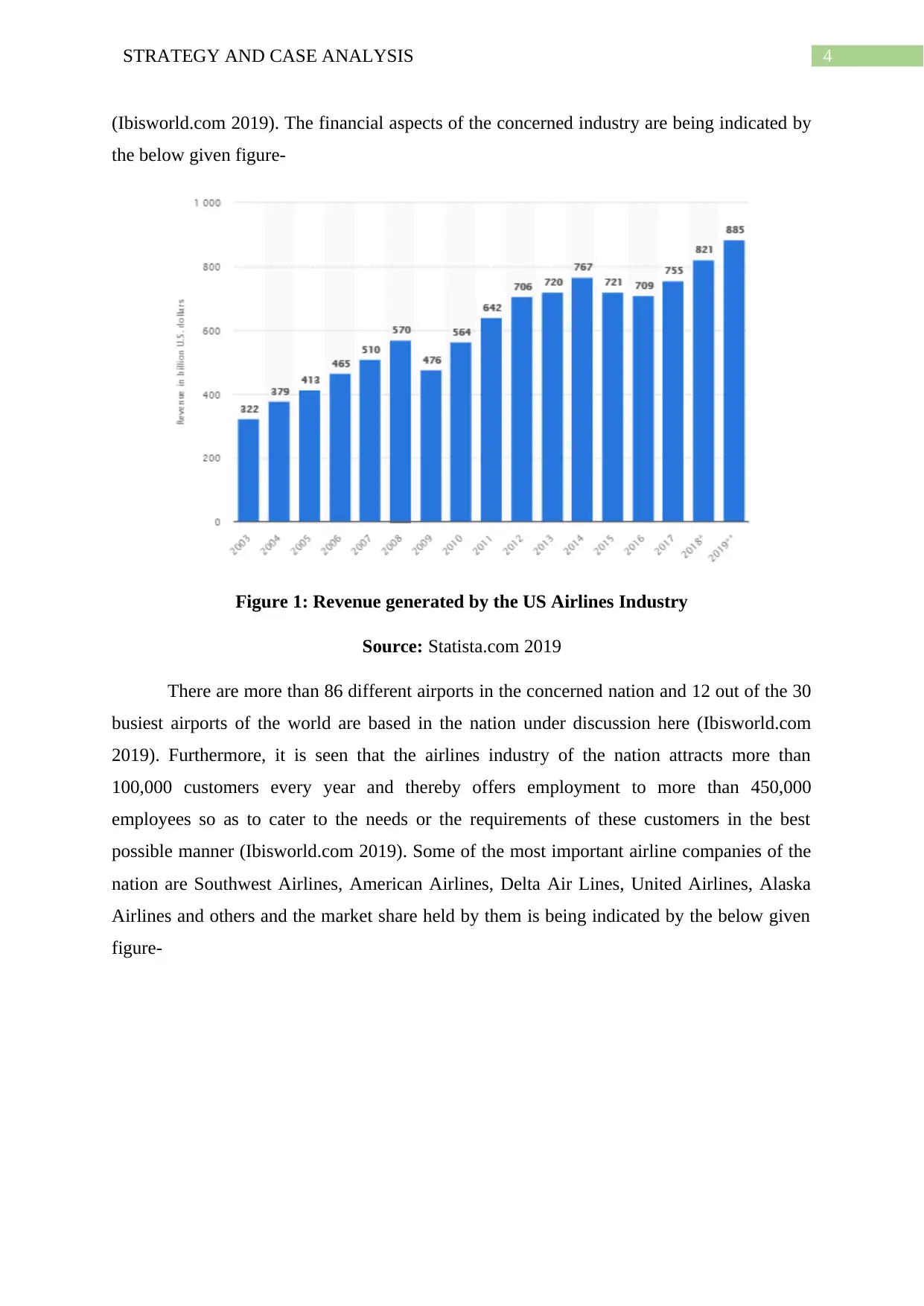
4STRATEGY AND CASE ANALYSIS
(Ibisworld.com 2019). The financial aspects of the concerned industry are being indicated by
the below given figure-
Figure 1: Revenue generated by the US Airlines Industry
Source: Statista.com 2019
There are more than 86 different airports in the concerned nation and 12 out of the 30
busiest airports of the world are based in the nation under discussion here (Ibisworld.com
2019). Furthermore, it is seen that the airlines industry of the nation attracts more than
100,000 customers every year and thereby offers employment to more than 450,000
employees so as to cater to the needs or the requirements of these customers in the best
possible manner (Ibisworld.com 2019). Some of the most important airline companies of the
nation are Southwest Airlines, American Airlines, Delta Air Lines, United Airlines, Alaska
Airlines and others and the market share held by them is being indicated by the below given
figure-
(Ibisworld.com 2019). The financial aspects of the concerned industry are being indicated by
the below given figure-
Figure 1: Revenue generated by the US Airlines Industry
Source: Statista.com 2019
There are more than 86 different airports in the concerned nation and 12 out of the 30
busiest airports of the world are based in the nation under discussion here (Ibisworld.com
2019). Furthermore, it is seen that the airlines industry of the nation attracts more than
100,000 customers every year and thereby offers employment to more than 450,000
employees so as to cater to the needs or the requirements of these customers in the best
possible manner (Ibisworld.com 2019). Some of the most important airline companies of the
nation are Southwest Airlines, American Airlines, Delta Air Lines, United Airlines, Alaska
Airlines and others and the market share held by them is being indicated by the below given
figure-
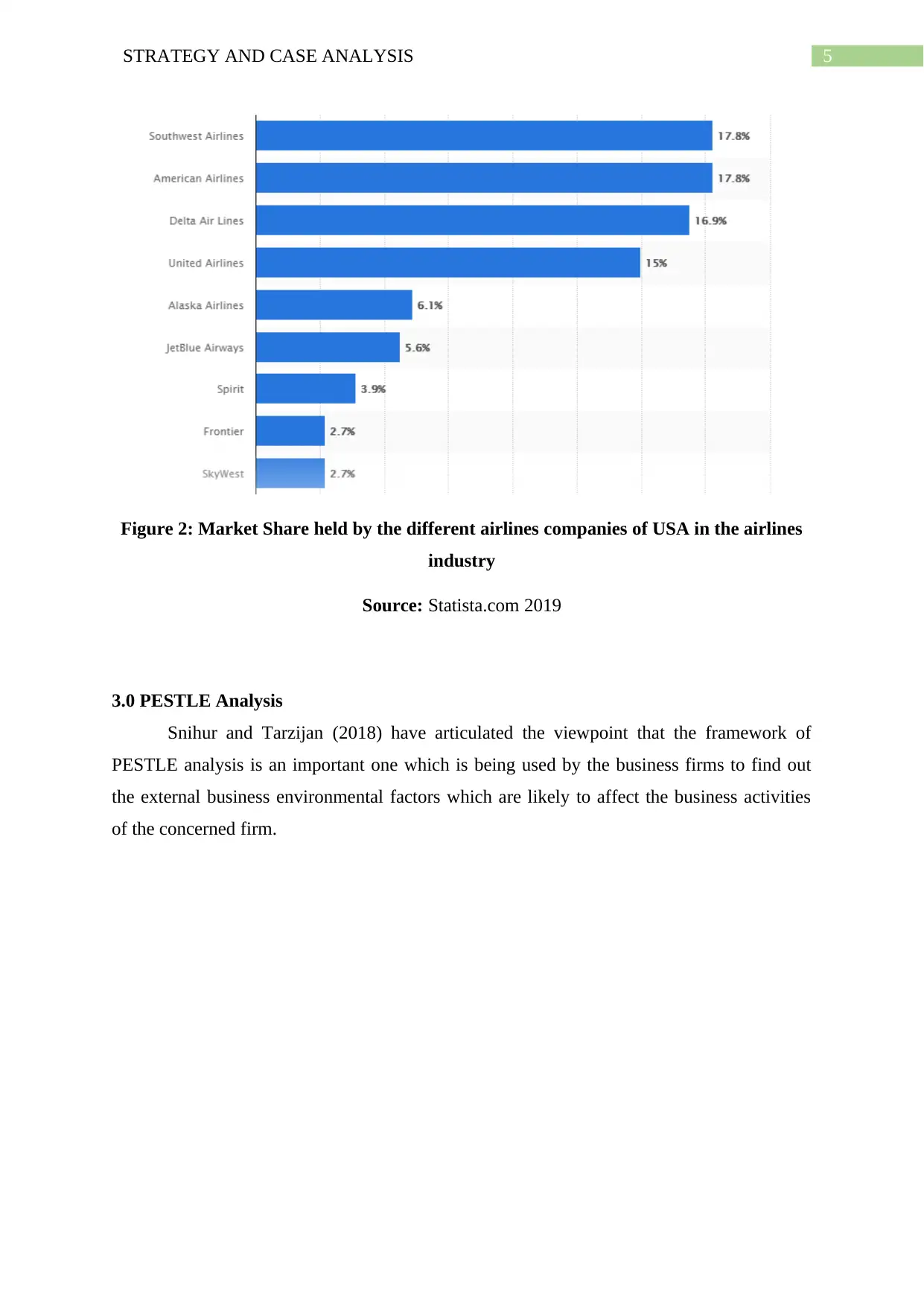
5STRATEGY AND CASE ANALYSIS
Figure 2: Market Share held by the different airlines companies of USA in the airlines
industry
Source: Statista.com 2019
3.0 PESTLE Analysis
Snihur and Tarzijan (2018) have articulated the viewpoint that the framework of
PESTLE analysis is an important one which is being used by the business firms to find out
the external business environmental factors which are likely to affect the business activities
of the concerned firm.
Figure 2: Market Share held by the different airlines companies of USA in the airlines
industry
Source: Statista.com 2019
3.0 PESTLE Analysis
Snihur and Tarzijan (2018) have articulated the viewpoint that the framework of
PESTLE analysis is an important one which is being used by the business firms to find out
the external business environmental factors which are likely to affect the business activities
of the concerned firm.
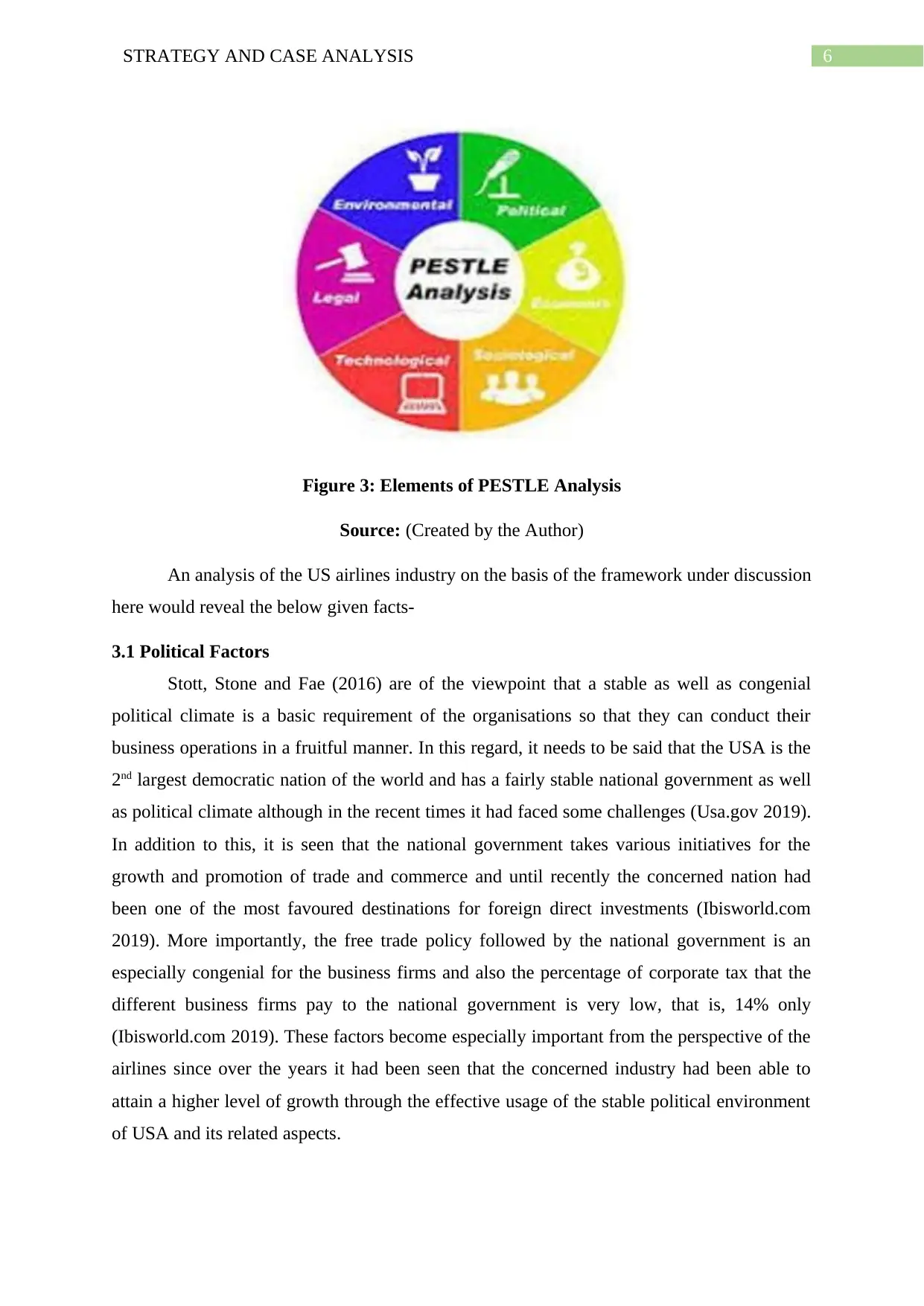
6STRATEGY AND CASE ANALYSIS
Figure 3: Elements of PESTLE Analysis
Source: (Created by the Author)
An analysis of the US airlines industry on the basis of the framework under discussion
here would reveal the below given facts-
3.1 Political Factors
Stott, Stone and Fae (2016) are of the viewpoint that a stable as well as congenial
political climate is a basic requirement of the organisations so that they can conduct their
business operations in a fruitful manner. In this regard, it needs to be said that the USA is the
2nd largest democratic nation of the world and has a fairly stable national government as well
as political climate although in the recent times it had faced some challenges (Usa.gov 2019).
In addition to this, it is seen that the national government takes various initiatives for the
growth and promotion of trade and commerce and until recently the concerned nation had
been one of the most favoured destinations for foreign direct investments (Ibisworld.com
2019). More importantly, the free trade policy followed by the national government is an
especially congenial for the business firms and also the percentage of corporate tax that the
different business firms pay to the national government is very low, that is, 14% only
(Ibisworld.com 2019). These factors become especially important from the perspective of the
airlines since over the years it had been seen that the concerned industry had been able to
attain a higher level of growth through the effective usage of the stable political environment
of USA and its related aspects.
Figure 3: Elements of PESTLE Analysis
Source: (Created by the Author)
An analysis of the US airlines industry on the basis of the framework under discussion
here would reveal the below given facts-
3.1 Political Factors
Stott, Stone and Fae (2016) are of the viewpoint that a stable as well as congenial
political climate is a basic requirement of the organisations so that they can conduct their
business operations in a fruitful manner. In this regard, it needs to be said that the USA is the
2nd largest democratic nation of the world and has a fairly stable national government as well
as political climate although in the recent times it had faced some challenges (Usa.gov 2019).
In addition to this, it is seen that the national government takes various initiatives for the
growth and promotion of trade and commerce and until recently the concerned nation had
been one of the most favoured destinations for foreign direct investments (Ibisworld.com
2019). More importantly, the free trade policy followed by the national government is an
especially congenial for the business firms and also the percentage of corporate tax that the
different business firms pay to the national government is very low, that is, 14% only
(Ibisworld.com 2019). These factors become especially important from the perspective of the
airlines since over the years it had been seen that the concerned industry had been able to
attain a higher level of growth through the effective usage of the stable political environment
of USA and its related aspects.
Paraphrase This Document
Need a fresh take? Get an instant paraphrase of this document with our AI Paraphraser
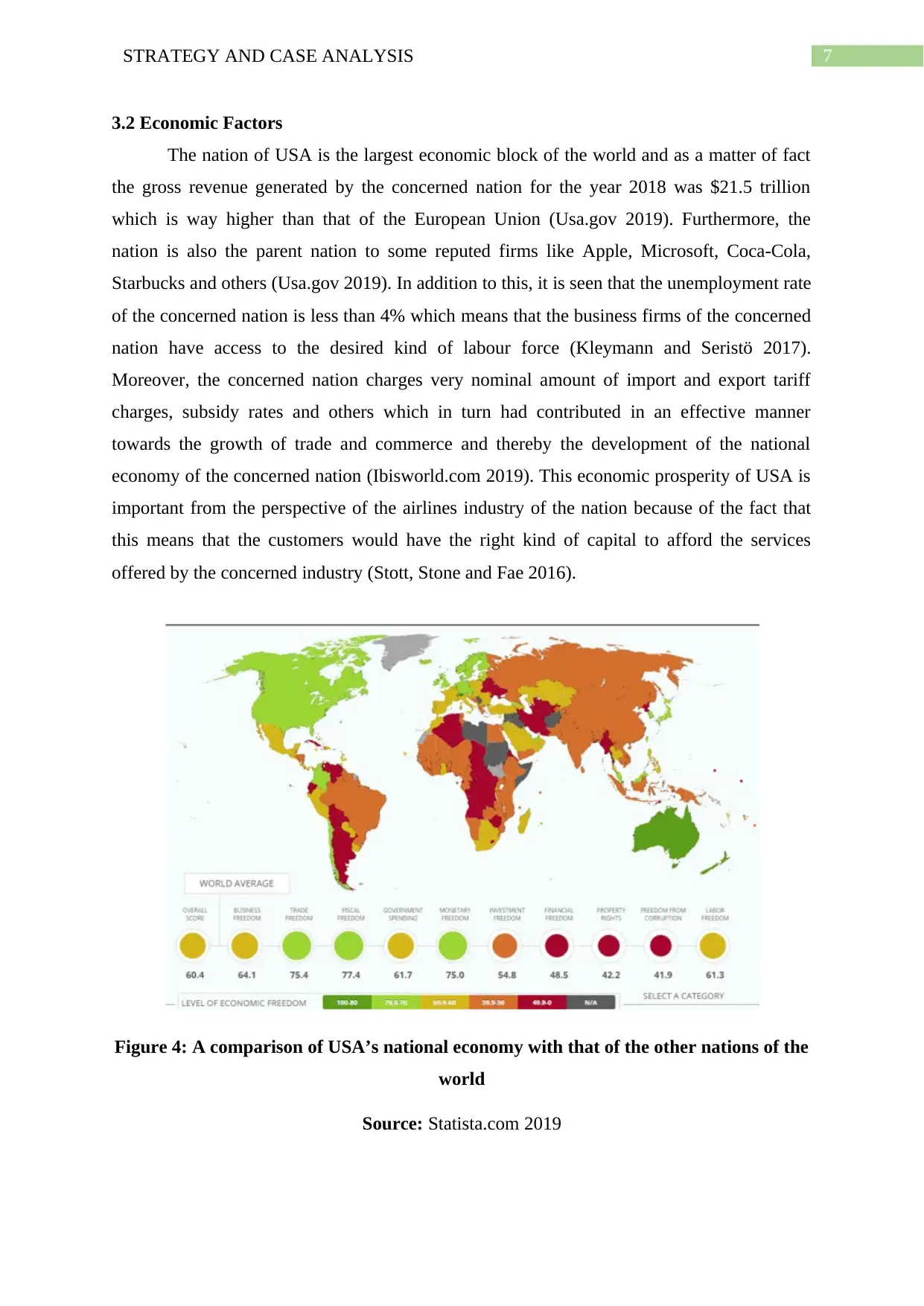
7STRATEGY AND CASE ANALYSIS
3.2 Economic Factors
The nation of USA is the largest economic block of the world and as a matter of fact
the gross revenue generated by the concerned nation for the year 2018 was $21.5 trillion
which is way higher than that of the European Union (Usa.gov 2019). Furthermore, the
nation is also the parent nation to some reputed firms like Apple, Microsoft, Coca-Cola,
Starbucks and others (Usa.gov 2019). In addition to this, it is seen that the unemployment rate
of the concerned nation is less than 4% which means that the business firms of the concerned
nation have access to the desired kind of labour force (Kleymann and Seristö 2017).
Moreover, the concerned nation charges very nominal amount of import and export tariff
charges, subsidy rates and others which in turn had contributed in an effective manner
towards the growth of trade and commerce and thereby the development of the national
economy of the concerned nation (Ibisworld.com 2019). This economic prosperity of USA is
important from the perspective of the airlines industry of the nation because of the fact that
this means that the customers would have the right kind of capital to afford the services
offered by the concerned industry (Stott, Stone and Fae 2016).
Figure 4: A comparison of USA’s national economy with that of the other nations of the
world
Source: Statista.com 2019
3.2 Economic Factors
The nation of USA is the largest economic block of the world and as a matter of fact
the gross revenue generated by the concerned nation for the year 2018 was $21.5 trillion
which is way higher than that of the European Union (Usa.gov 2019). Furthermore, the
nation is also the parent nation to some reputed firms like Apple, Microsoft, Coca-Cola,
Starbucks and others (Usa.gov 2019). In addition to this, it is seen that the unemployment rate
of the concerned nation is less than 4% which means that the business firms of the concerned
nation have access to the desired kind of labour force (Kleymann and Seristö 2017).
Moreover, the concerned nation charges very nominal amount of import and export tariff
charges, subsidy rates and others which in turn had contributed in an effective manner
towards the growth of trade and commerce and thereby the development of the national
economy of the concerned nation (Ibisworld.com 2019). This economic prosperity of USA is
important from the perspective of the airlines industry of the nation because of the fact that
this means that the customers would have the right kind of capital to afford the services
offered by the concerned industry (Stott, Stone and Fae 2016).
Figure 4: A comparison of USA’s national economy with that of the other nations of the
world
Source: Statista.com 2019
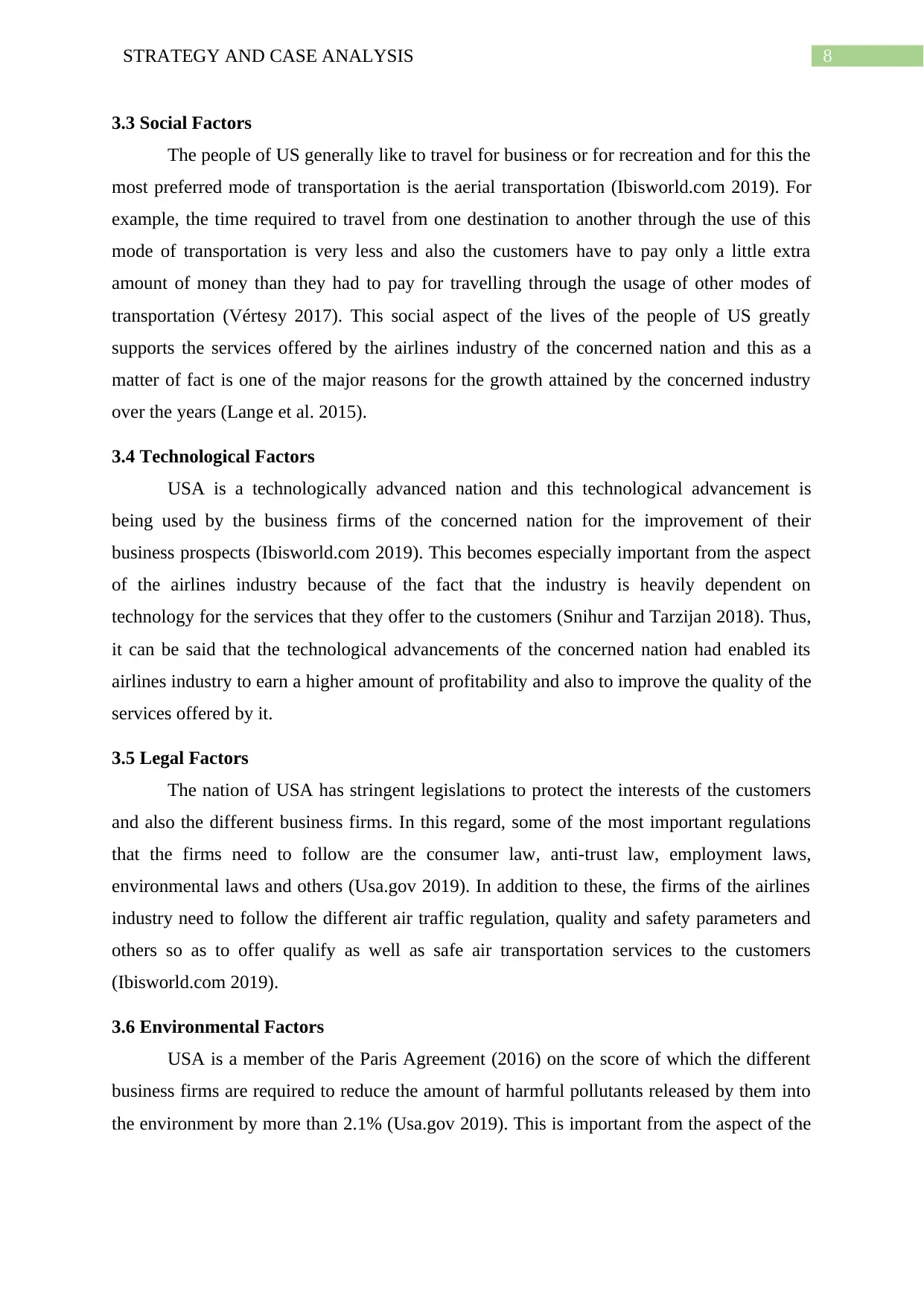
8STRATEGY AND CASE ANALYSIS
3.3 Social Factors
The people of US generally like to travel for business or for recreation and for this the
most preferred mode of transportation is the aerial transportation (Ibisworld.com 2019). For
example, the time required to travel from one destination to another through the use of this
mode of transportation is very less and also the customers have to pay only a little extra
amount of money than they had to pay for travelling through the usage of other modes of
transportation (Vértesy 2017). This social aspect of the lives of the people of US greatly
supports the services offered by the airlines industry of the concerned nation and this as a
matter of fact is one of the major reasons for the growth attained by the concerned industry
over the years (Lange et al. 2015).
3.4 Technological Factors
USA is a technologically advanced nation and this technological advancement is
being used by the business firms of the concerned nation for the improvement of their
business prospects (Ibisworld.com 2019). This becomes especially important from the aspect
of the airlines industry because of the fact that the industry is heavily dependent on
technology for the services that they offer to the customers (Snihur and Tarzijan 2018). Thus,
it can be said that the technological advancements of the concerned nation had enabled its
airlines industry to earn a higher amount of profitability and also to improve the quality of the
services offered by it.
3.5 Legal Factors
The nation of USA has stringent legislations to protect the interests of the customers
and also the different business firms. In this regard, some of the most important regulations
that the firms need to follow are the consumer law, anti-trust law, employment laws,
environmental laws and others (Usa.gov 2019). In addition to these, the firms of the airlines
industry need to follow the different air traffic regulation, quality and safety parameters and
others so as to offer qualify as well as safe air transportation services to the customers
(Ibisworld.com 2019).
3.6 Environmental Factors
USA is a member of the Paris Agreement (2016) on the score of which the different
business firms are required to reduce the amount of harmful pollutants released by them into
the environment by more than 2.1% (Usa.gov 2019). This is important from the aspect of the
3.3 Social Factors
The people of US generally like to travel for business or for recreation and for this the
most preferred mode of transportation is the aerial transportation (Ibisworld.com 2019). For
example, the time required to travel from one destination to another through the use of this
mode of transportation is very less and also the customers have to pay only a little extra
amount of money than they had to pay for travelling through the usage of other modes of
transportation (Vértesy 2017). This social aspect of the lives of the people of US greatly
supports the services offered by the airlines industry of the concerned nation and this as a
matter of fact is one of the major reasons for the growth attained by the concerned industry
over the years (Lange et al. 2015).
3.4 Technological Factors
USA is a technologically advanced nation and this technological advancement is
being used by the business firms of the concerned nation for the improvement of their
business prospects (Ibisworld.com 2019). This becomes especially important from the aspect
of the airlines industry because of the fact that the industry is heavily dependent on
technology for the services that they offer to the customers (Snihur and Tarzijan 2018). Thus,
it can be said that the technological advancements of the concerned nation had enabled its
airlines industry to earn a higher amount of profitability and also to improve the quality of the
services offered by it.
3.5 Legal Factors
The nation of USA has stringent legislations to protect the interests of the customers
and also the different business firms. In this regard, some of the most important regulations
that the firms need to follow are the consumer law, anti-trust law, employment laws,
environmental laws and others (Usa.gov 2019). In addition to these, the firms of the airlines
industry need to follow the different air traffic regulation, quality and safety parameters and
others so as to offer qualify as well as safe air transportation services to the customers
(Ibisworld.com 2019).
3.6 Environmental Factors
USA is a member of the Paris Agreement (2016) on the score of which the different
business firms are required to reduce the amount of harmful pollutants released by them into
the environment by more than 2.1% (Usa.gov 2019). This is important from the aspect of the

9STRATEGY AND CASE ANALYSIS
airlines industry because the airline companies are the major contributors towards the air
pollution (Ibisworld.com 2019).
4.0 Competitive Forces Analysis
Hannigan, Hamilton III and Mudambi (2015) have articulated the viewpoint that
Porter’s Five Forces Model is one of the most common frameworks which is being to analyse
the level of business competition that they face within the industry of their operation.
Figure 5: Components of Porter’s Five Forces Model
Source: (Created by the Author)
An analysis of the US airline industry on the basis of this framework would reveal the
following facts-
Bargaining Power of the Buyers As opined by Grant (2016), high bargaining power
of the buyers adversely affects the prospects of the
business firms. Within the US airlines industry, it is
seen that because of the large number of airline
companies the options which are available to the
customers and also the cost of switching from one
brand to another is low (Burghouwt 2016). This in
turn accounts for the high power of the buyers in the
concerned industry of USA.
Bargaining Power of the
Suppliers
As stated by Jarach (2017), if the bargaining power
of the suppliers which are related to the firms is high
then this is likely to adversely affect the profitability
of the firms. Within the particular context of the US
airlines industry because the airline companies are the major contributors towards the air
pollution (Ibisworld.com 2019).
4.0 Competitive Forces Analysis
Hannigan, Hamilton III and Mudambi (2015) have articulated the viewpoint that
Porter’s Five Forces Model is one of the most common frameworks which is being to analyse
the level of business competition that they face within the industry of their operation.
Figure 5: Components of Porter’s Five Forces Model
Source: (Created by the Author)
An analysis of the US airline industry on the basis of this framework would reveal the
following facts-
Bargaining Power of the Buyers As opined by Grant (2016), high bargaining power
of the buyers adversely affects the prospects of the
business firms. Within the US airlines industry, it is
seen that because of the large number of airline
companies the options which are available to the
customers and also the cost of switching from one
brand to another is low (Burghouwt 2016). This in
turn accounts for the high power of the buyers in the
concerned industry of USA.
Bargaining Power of the
Suppliers
As stated by Jarach (2017), if the bargaining power
of the suppliers which are related to the firms is high
then this is likely to adversely affect the profitability
of the firms. Within the particular context of the US
Secure Best Marks with AI Grader
Need help grading? Try our AI Grader for instant feedback on your assignments.
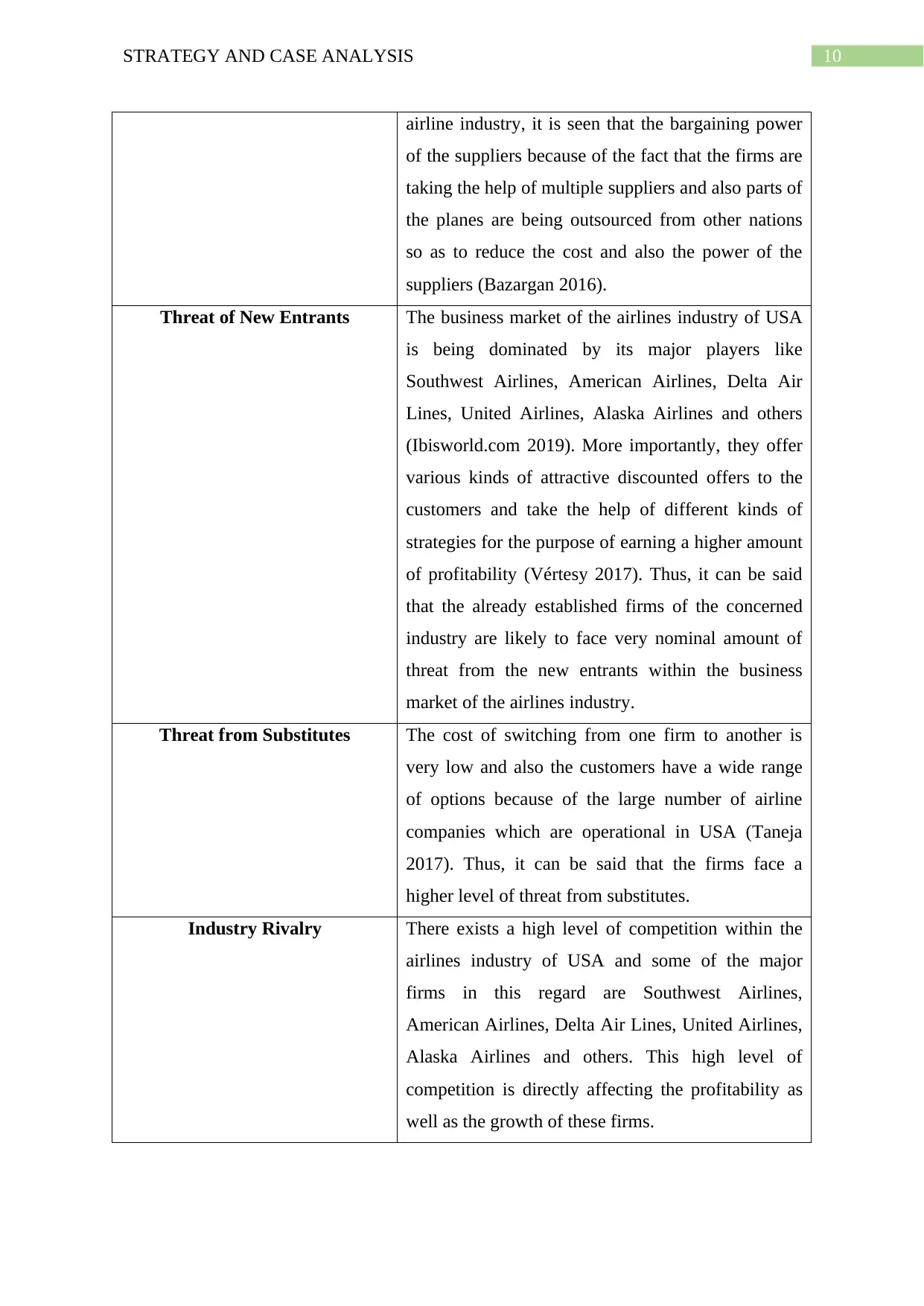
10STRATEGY AND CASE ANALYSIS
airline industry, it is seen that the bargaining power
of the suppliers because of the fact that the firms are
taking the help of multiple suppliers and also parts of
the planes are being outsourced from other nations
so as to reduce the cost and also the power of the
suppliers (Bazargan 2016).
Threat of New Entrants The business market of the airlines industry of USA
is being dominated by its major players like
Southwest Airlines, American Airlines, Delta Air
Lines, United Airlines, Alaska Airlines and others
(Ibisworld.com 2019). More importantly, they offer
various kinds of attractive discounted offers to the
customers and take the help of different kinds of
strategies for the purpose of earning a higher amount
of profitability (Vértesy 2017). Thus, it can be said
that the already established firms of the concerned
industry are likely to face very nominal amount of
threat from the new entrants within the business
market of the airlines industry.
Threat from Substitutes The cost of switching from one firm to another is
very low and also the customers have a wide range
of options because of the large number of airline
companies which are operational in USA (Taneja
2017). Thus, it can be said that the firms face a
higher level of threat from substitutes.
Industry Rivalry There exists a high level of competition within the
airlines industry of USA and some of the major
firms in this regard are Southwest Airlines,
American Airlines, Delta Air Lines, United Airlines,
Alaska Airlines and others. This high level of
competition is directly affecting the profitability as
well as the growth of these firms.
airline industry, it is seen that the bargaining power
of the suppliers because of the fact that the firms are
taking the help of multiple suppliers and also parts of
the planes are being outsourced from other nations
so as to reduce the cost and also the power of the
suppliers (Bazargan 2016).
Threat of New Entrants The business market of the airlines industry of USA
is being dominated by its major players like
Southwest Airlines, American Airlines, Delta Air
Lines, United Airlines, Alaska Airlines and others
(Ibisworld.com 2019). More importantly, they offer
various kinds of attractive discounted offers to the
customers and take the help of different kinds of
strategies for the purpose of earning a higher amount
of profitability (Vértesy 2017). Thus, it can be said
that the already established firms of the concerned
industry are likely to face very nominal amount of
threat from the new entrants within the business
market of the airlines industry.
Threat from Substitutes The cost of switching from one firm to another is
very low and also the customers have a wide range
of options because of the large number of airline
companies which are operational in USA (Taneja
2017). Thus, it can be said that the firms face a
higher level of threat from substitutes.
Industry Rivalry There exists a high level of competition within the
airlines industry of USA and some of the major
firms in this regard are Southwest Airlines,
American Airlines, Delta Air Lines, United Airlines,
Alaska Airlines and others. This high level of
competition is directly affecting the profitability as
well as the growth of these firms.
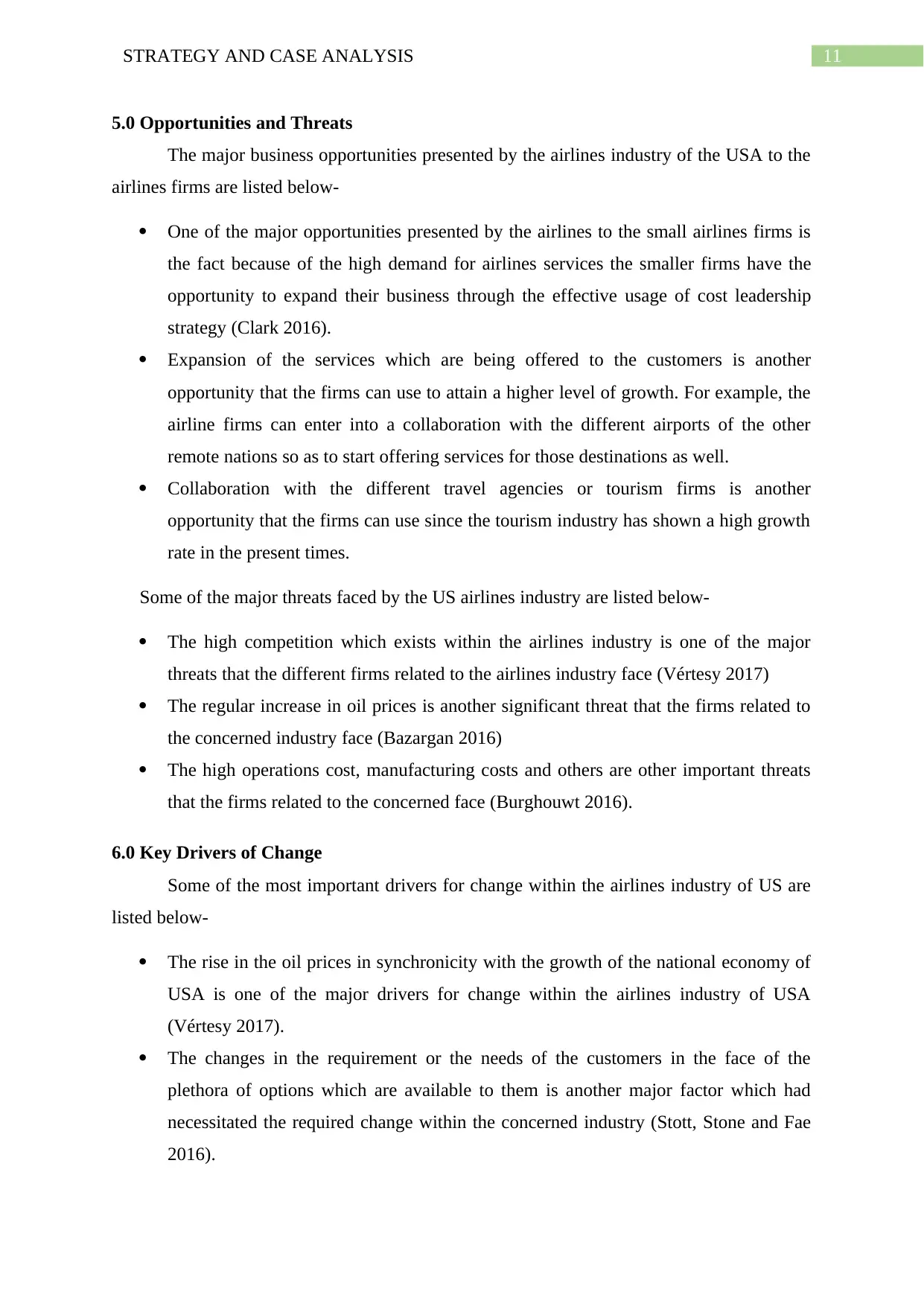
11STRATEGY AND CASE ANALYSIS
5.0 Opportunities and Threats
The major business opportunities presented by the airlines industry of the USA to the
airlines firms are listed below-
One of the major opportunities presented by the airlines to the small airlines firms is
the fact because of the high demand for airlines services the smaller firms have the
opportunity to expand their business through the effective usage of cost leadership
strategy (Clark 2016).
Expansion of the services which are being offered to the customers is another
opportunity that the firms can use to attain a higher level of growth. For example, the
airline firms can enter into a collaboration with the different airports of the other
remote nations so as to start offering services for those destinations as well.
Collaboration with the different travel agencies or tourism firms is another
opportunity that the firms can use since the tourism industry has shown a high growth
rate in the present times.
Some of the major threats faced by the US airlines industry are listed below-
The high competition which exists within the airlines industry is one of the major
threats that the different firms related to the airlines industry face (Vértesy 2017)
The regular increase in oil prices is another significant threat that the firms related to
the concerned industry face (Bazargan 2016)
The high operations cost, manufacturing costs and others are other important threats
that the firms related to the concerned face (Burghouwt 2016).
6.0 Key Drivers of Change
Some of the most important drivers for change within the airlines industry of US are
listed below-
The rise in the oil prices in synchronicity with the growth of the national economy of
USA is one of the major drivers for change within the airlines industry of USA
(Vértesy 2017).
The changes in the requirement or the needs of the customers in the face of the
plethora of options which are available to them is another major factor which had
necessitated the required change within the concerned industry (Stott, Stone and Fae
2016).
5.0 Opportunities and Threats
The major business opportunities presented by the airlines industry of the USA to the
airlines firms are listed below-
One of the major opportunities presented by the airlines to the small airlines firms is
the fact because of the high demand for airlines services the smaller firms have the
opportunity to expand their business through the effective usage of cost leadership
strategy (Clark 2016).
Expansion of the services which are being offered to the customers is another
opportunity that the firms can use to attain a higher level of growth. For example, the
airline firms can enter into a collaboration with the different airports of the other
remote nations so as to start offering services for those destinations as well.
Collaboration with the different travel agencies or tourism firms is another
opportunity that the firms can use since the tourism industry has shown a high growth
rate in the present times.
Some of the major threats faced by the US airlines industry are listed below-
The high competition which exists within the airlines industry is one of the major
threats that the different firms related to the airlines industry face (Vértesy 2017)
The regular increase in oil prices is another significant threat that the firms related to
the concerned industry face (Bazargan 2016)
The high operations cost, manufacturing costs and others are other important threats
that the firms related to the concerned face (Burghouwt 2016).
6.0 Key Drivers of Change
Some of the most important drivers for change within the airlines industry of US are
listed below-
The rise in the oil prices in synchronicity with the growth of the national economy of
USA is one of the major drivers for change within the airlines industry of USA
(Vértesy 2017).
The changes in the requirement or the needs of the customers in the face of the
plethora of options which are available to them is another major factor which had
necessitated the required change within the concerned industry (Stott, Stone and Fae
2016).
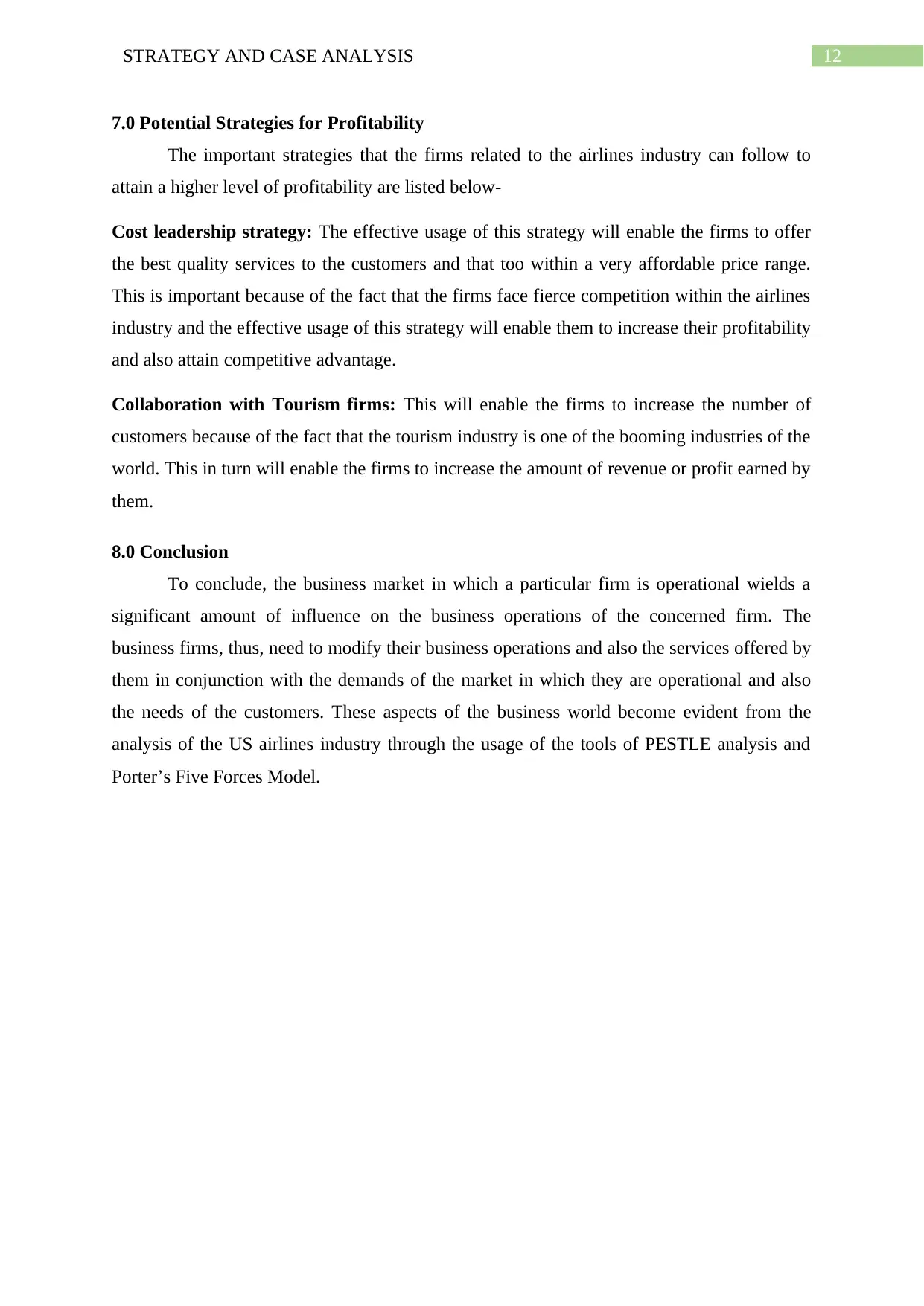
12STRATEGY AND CASE ANALYSIS
7.0 Potential Strategies for Profitability
The important strategies that the firms related to the airlines industry can follow to
attain a higher level of profitability are listed below-
Cost leadership strategy: The effective usage of this strategy will enable the firms to offer
the best quality services to the customers and that too within a very affordable price range.
This is important because of the fact that the firms face fierce competition within the airlines
industry and the effective usage of this strategy will enable them to increase their profitability
and also attain competitive advantage.
Collaboration with Tourism firms: This will enable the firms to increase the number of
customers because of the fact that the tourism industry is one of the booming industries of the
world. This in turn will enable the firms to increase the amount of revenue or profit earned by
them.
8.0 Conclusion
To conclude, the business market in which a particular firm is operational wields a
significant amount of influence on the business operations of the concerned firm. The
business firms, thus, need to modify their business operations and also the services offered by
them in conjunction with the demands of the market in which they are operational and also
the needs of the customers. These aspects of the business world become evident from the
analysis of the US airlines industry through the usage of the tools of PESTLE analysis and
Porter’s Five Forces Model.
7.0 Potential Strategies for Profitability
The important strategies that the firms related to the airlines industry can follow to
attain a higher level of profitability are listed below-
Cost leadership strategy: The effective usage of this strategy will enable the firms to offer
the best quality services to the customers and that too within a very affordable price range.
This is important because of the fact that the firms face fierce competition within the airlines
industry and the effective usage of this strategy will enable them to increase their profitability
and also attain competitive advantage.
Collaboration with Tourism firms: This will enable the firms to increase the number of
customers because of the fact that the tourism industry is one of the booming industries of the
world. This in turn will enable the firms to increase the amount of revenue or profit earned by
them.
8.0 Conclusion
To conclude, the business market in which a particular firm is operational wields a
significant amount of influence on the business operations of the concerned firm. The
business firms, thus, need to modify their business operations and also the services offered by
them in conjunction with the demands of the market in which they are operational and also
the needs of the customers. These aspects of the business world become evident from the
analysis of the US airlines industry through the usage of the tools of PESTLE analysis and
Porter’s Five Forces Model.
Paraphrase This Document
Need a fresh take? Get an instant paraphrase of this document with our AI Paraphraser

13STRATEGY AND CASE ANALYSIS
9.0 References
Bazargan, M., 2016. Airline operations and scheduling. Routledge.
Burghouwt, G., 2016. Airline network development in Europe and its implications for airport
planning. Routledge.
Clark, P., 2016. Stormy skies: airlines in crisis. Routledge.
Grant, R.M., 2016. Contemporary strategy analysis: Text and cases edition. John Wiley &
Sons.
Hamilton, L. and Webster, P., 2018. The international business environment. Oxford
University Press.
Hannigan, T.J., Hamilton III, R.D. and Mudambi, R., 2015. Competition and competitiveness
in the US airline industry. Competitiveness Review, 25(2), pp.134-155.
Ibisworld.com 2019. IBISWorld - Industry Market Research, Reports, and Statistics. [online]
Available at: https://www.ibisworld.com/industry-trends/market-research-reports/
transportation-warehousing/air/international-airlines.html [Accessed 12 Apr. 2019].
Jarach, D., 2017. Airport marketing: Strategies to cope with the new millennium environment.
Routledge.
Kleymann, B. and Seristö, H., 2017. Managing strategic airline alliances. Routledge.
Lange, K., Geppert, M., Saka‐Helmhout, A. and Becker‐Ritterspach, F., 2015. Changing
business models and employee representation in the airline industry: A comparison of British
Airways and Deutsche Lufthansa. British Journal of Management, 26(3), pp.388-407.
Schmitt, A., Barker III, V.L., Raisch, S. and Whetten, D., 2016. Strategic renewal in times of
environmental scarcity. Long Range Planning, 49(3), pp.361-376.
Snihur, Y. and Tarzijan, J., 2018. Managing complexity in a multi-business-model
organization. Long Range Planning, 51(1), pp.50-63.
Statista.com 2019. Airline industry revenue worldwide 2019 | Statista. [online] Available at:
https://www.statista.com/statistics/278372/revenue-of-commercial-airlines-worldwide/
[Accessed 12 Apr. 2019].
9.0 References
Bazargan, M., 2016. Airline operations and scheduling. Routledge.
Burghouwt, G., 2016. Airline network development in Europe and its implications for airport
planning. Routledge.
Clark, P., 2016. Stormy skies: airlines in crisis. Routledge.
Grant, R.M., 2016. Contemporary strategy analysis: Text and cases edition. John Wiley &
Sons.
Hamilton, L. and Webster, P., 2018. The international business environment. Oxford
University Press.
Hannigan, T.J., Hamilton III, R.D. and Mudambi, R., 2015. Competition and competitiveness
in the US airline industry. Competitiveness Review, 25(2), pp.134-155.
Ibisworld.com 2019. IBISWorld - Industry Market Research, Reports, and Statistics. [online]
Available at: https://www.ibisworld.com/industry-trends/market-research-reports/
transportation-warehousing/air/international-airlines.html [Accessed 12 Apr. 2019].
Jarach, D., 2017. Airport marketing: Strategies to cope with the new millennium environment.
Routledge.
Kleymann, B. and Seristö, H., 2017. Managing strategic airline alliances. Routledge.
Lange, K., Geppert, M., Saka‐Helmhout, A. and Becker‐Ritterspach, F., 2015. Changing
business models and employee representation in the airline industry: A comparison of British
Airways and Deutsche Lufthansa. British Journal of Management, 26(3), pp.388-407.
Schmitt, A., Barker III, V.L., Raisch, S. and Whetten, D., 2016. Strategic renewal in times of
environmental scarcity. Long Range Planning, 49(3), pp.361-376.
Snihur, Y. and Tarzijan, J., 2018. Managing complexity in a multi-business-model
organization. Long Range Planning, 51(1), pp.50-63.
Statista.com 2019. Airline industry revenue worldwide 2019 | Statista. [online] Available at:
https://www.statista.com/statistics/278372/revenue-of-commercial-airlines-worldwide/
[Accessed 12 Apr. 2019].
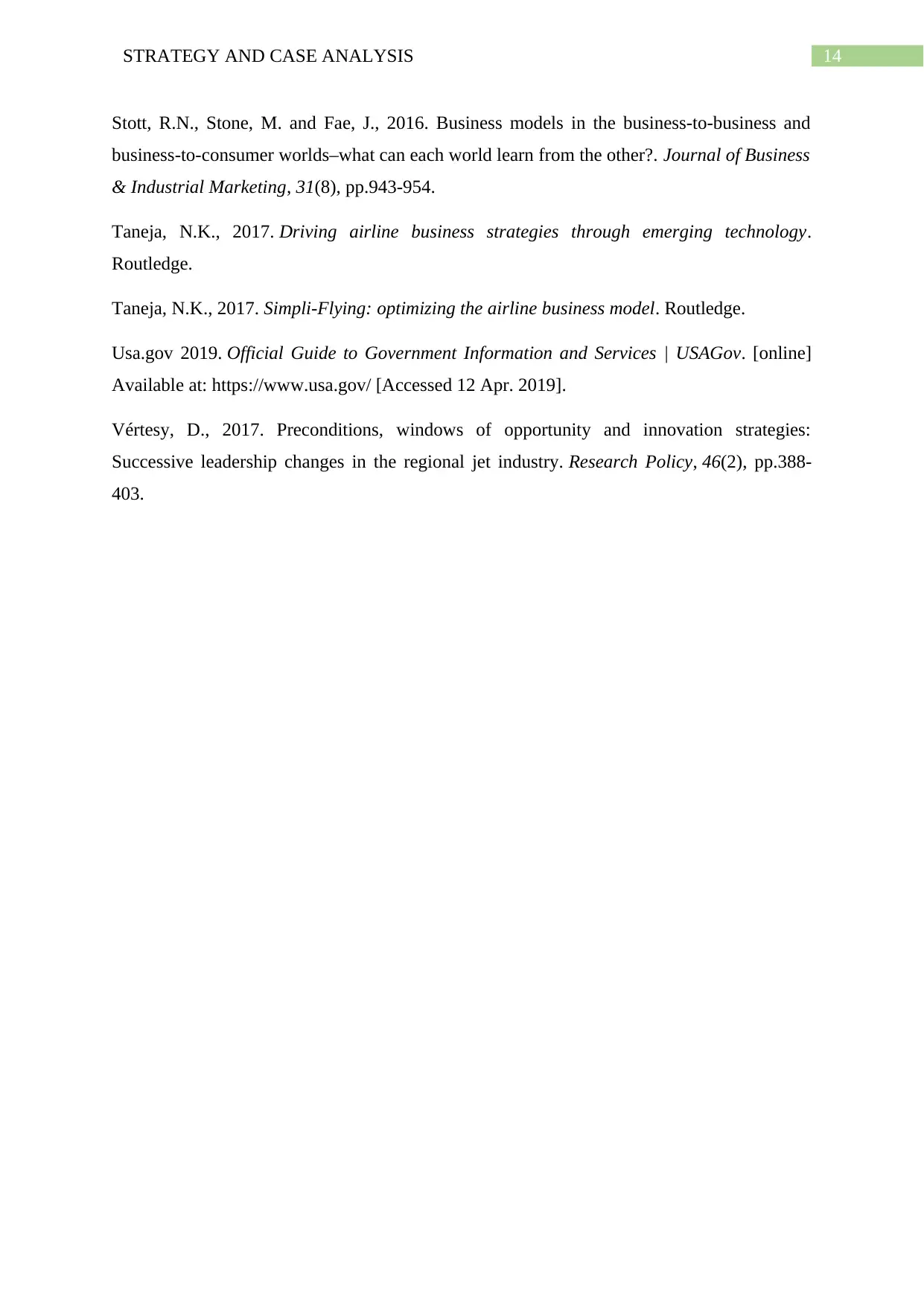
14STRATEGY AND CASE ANALYSIS
Stott, R.N., Stone, M. and Fae, J., 2016. Business models in the business-to-business and
business-to-consumer worlds–what can each world learn from the other?. Journal of Business
& Industrial Marketing, 31(8), pp.943-954.
Taneja, N.K., 2017. Driving airline business strategies through emerging technology.
Routledge.
Taneja, N.K., 2017. Simpli-Flying: optimizing the airline business model. Routledge.
Usa.gov 2019. Official Guide to Government Information and Services | USAGov. [online]
Available at: https://www.usa.gov/ [Accessed 12 Apr. 2019].
Vértesy, D., 2017. Preconditions, windows of opportunity and innovation strategies:
Successive leadership changes in the regional jet industry. Research Policy, 46(2), pp.388-
403.
Stott, R.N., Stone, M. and Fae, J., 2016. Business models in the business-to-business and
business-to-consumer worlds–what can each world learn from the other?. Journal of Business
& Industrial Marketing, 31(8), pp.943-954.
Taneja, N.K., 2017. Driving airline business strategies through emerging technology.
Routledge.
Taneja, N.K., 2017. Simpli-Flying: optimizing the airline business model. Routledge.
Usa.gov 2019. Official Guide to Government Information and Services | USAGov. [online]
Available at: https://www.usa.gov/ [Accessed 12 Apr. 2019].
Vértesy, D., 2017. Preconditions, windows of opportunity and innovation strategies:
Successive leadership changes in the regional jet industry. Research Policy, 46(2), pp.388-
403.
1 out of 15
Related Documents
Your All-in-One AI-Powered Toolkit for Academic Success.
+13062052269
info@desklib.com
Available 24*7 on WhatsApp / Email
![[object Object]](/_next/static/media/star-bottom.7253800d.svg)
Unlock your academic potential
© 2024 | Zucol Services PVT LTD | All rights reserved.





